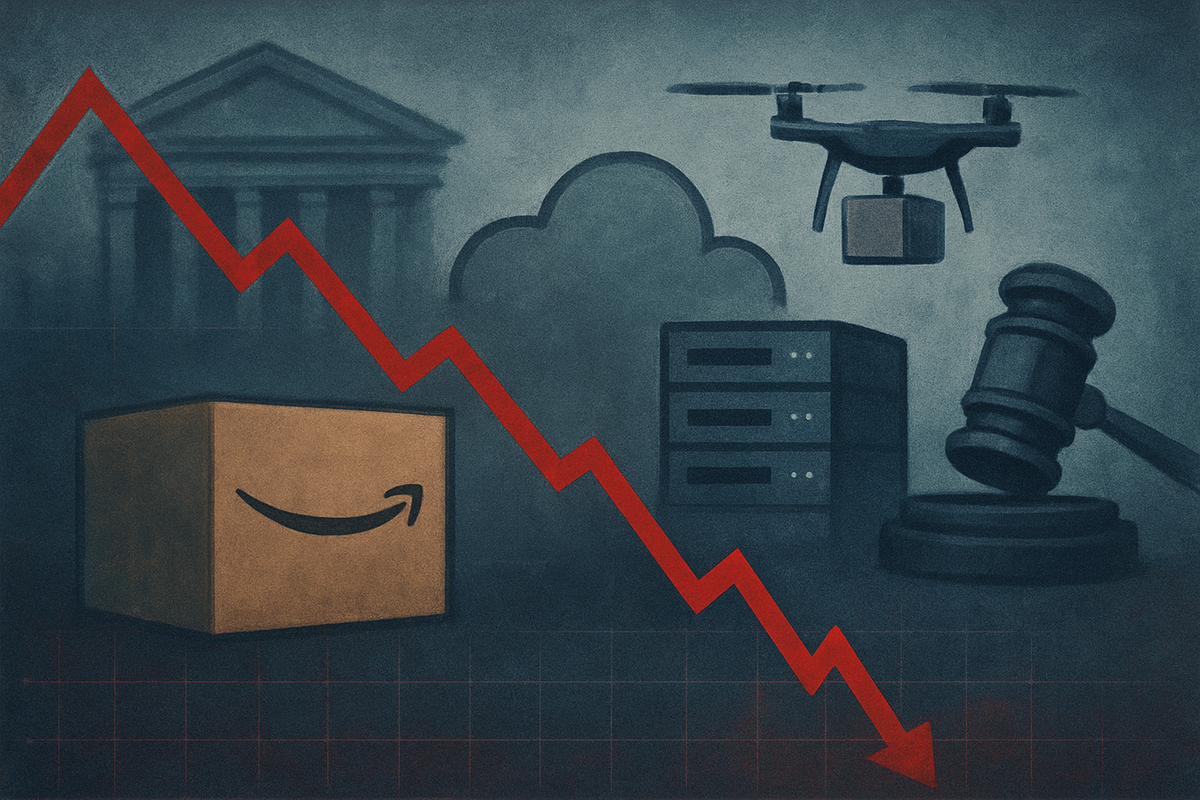
Amazon (NASDAQ: AMZN) found itself at the bottom of market performers today, November 20, 2025, as a confluence of negative news rattled investor confidence. The e-commerce and cloud giant's stock experienced a significant downturn following a surprisingly weak Q3 2025 earnings guidance announcement and intensified regulatory pressures from a newly aggressive Department of Justice. This double whammy has raised serious questions about Amazon's near-term growth trajectory and long-term market dominance.
The immediate implications are a broad sell-off, not just in Amazon shares but also casting a shadow over the broader tech sector, particularly companies reliant on consumer spending and cloud services. Analysts are quickly recalibrating their price targets, and market sentiment has shifted from cautious optimism to outright concern regarding the company's ability to maintain its previously robust growth rates in a challenging economic and regulatory environment.
A Perfect Storm: Weak Guidance Meets Regulatory Headwinds
The primary catalyst for today's steep decline was Amazon's release of its Q3 2025 earnings guidance, which fell significantly short of Wall Street's expectations. The company projected revenue growth in the low single digits, citing softening consumer demand in key markets, increased competition in e-commerce, and higher operational costs associated with its global logistics network. This guidance suggests a more pronounced slowdown than many investors had anticipated, particularly concerning its traditionally resilient Amazon Web Services (AWS) segment, which also showed signs of decelerating growth.
Compounding this financial setback, the Department of Justice (DOJ) announced a new, expanded antitrust investigation into Amazon's business practices, particularly focusing on its dual role as a marketplace operator and a direct seller, and its alleged anti-competitive behavior in the cloud computing space. This follows a timeline of increasing regulatory scrutiny that began several years ago, escalating with recent legislative proposals aimed at curbing the power of large tech companies. Key players involved include Attorney General Jane Doe, who has publicly advocated for stricter enforcement of antitrust laws, and a coalition of small businesses and tech startups that have long accused Amazon of leveraging its market power unfairly. Initial market reactions have been swift, with investors fearing protracted legal battles, potential forced divestitures, or significant operational restrictions that could hinder innovation and profitability.
Ripple Effects: Winners and Losers in a Shifting Landscape
The downturn in Amazon's fortunes is poised to create both winners and losers across the market. Companies directly competing with Amazon's core businesses stand to gain. Retailers like Walmart (NYSE: WMT) and Target (NYSE: TGT) could see increased market share in the e-commerce space if Amazon's growth falters or its competitive practices are curtailed. Similarly, cloud providers such as Microsoft (NASDAQ: MSFT) with Azure and Alphabet (NASDAQ: GOOGL) with Google Cloud could benefit from any perceived weakness or regulatory constraints placed on AWS, potentially attracting new enterprise clients looking for diversified cloud solutions.
However, companies deeply integrated into Amazon's ecosystem, such as third-party sellers on its marketplace or logistics partners, might face headwinds. A slowdown in Amazon's sales or changes in its seller policies due to regulatory pressure could negatively impact their revenues and operational models. Additionally, the broader tech sector, especially other large-cap growth stocks, could experience a contagion effect as investors become more risk-averse, leading to a re-evaluation of high-valuation tech companies across the board. The investment community will be closely watching how Amazon navigates these challenges, as its response could set a precedent for how other tech giants address similar issues.
Wider Significance: A Bellwether for Big Tech's Future
This event is more than just a setback for one company; it's a bellwether for broader industry trends, particularly the ongoing debate around big tech's influence and regulatory oversight. The intensified antitrust scrutiny of Amazon fits into a global pattern of governments attempting to rein in the power of digital behemoths. This could signal a new era of stricter enforcement, potentially leading to more fragmented markets and increased competition, which could ultimately benefit consumers but challenge the established business models of tech giants.
Potential ripple effects on competitors and partners are significant. If Amazon is forced to alter its business practices, it could create opportunities for smaller players to innovate and grow. Regulatory or policy implications could include new legislation aimed at platform neutrality, data portability, and stricter merger reviews. Historically, similar antitrust actions against companies like Microsoft in the late 1990s led to significant changes in their business strategies and the broader tech landscape. While direct comparisons are difficult due to the unique nature of Amazon's diversified business, the underlying principle of balancing innovation with fair competition remains a constant theme.
What Comes Next: Navigating Uncertainty
In the short term, Amazon (NASDAQ: AMZN) will likely face continued stock volatility as investors digest the implications of both the disappointing guidance and the escalated antitrust probe. The company's immediate focus will be on damage control, potentially issuing more detailed explanations for its Q3 outlook and outlining its strategy to address regulatory concerns. Short-term possibilities include increased share buybacks to stabilize the stock, though the primary challenge will be restoring investor confidence in its long-term growth story.
Long-term possibilities involve significant strategic pivots. Amazon might need to reconsider aspects of its marketplace operations, potentially separating its retail and third-party seller functions to appease regulators. For AWS, increased competition and regulatory pressure might force more transparent pricing or interoperability standards. Market opportunities could emerge for competitors who can capitalize on Amazon's potential distractions, while challenges will include maintaining innovation and customer loyalty amidst external pressures. Potential scenarios range from a successful navigation of these headwinds, leading to a more streamlined and compliant Amazon, to a more challenging outcome involving significant operational restructuring or fines that could fundamentally alter its market position.
Wrap-Up: A Crossroads for the E-commerce Giant
Today's sharp decline in Amazon's (NASDAQ: AMZN) stock marks a critical juncture for the e-commerce and cloud computing behemoth. The combination of weaker-than-expected Q3 guidance and intensified antitrust scrutiny has created a challenging environment, forcing investors to re-evaluate the company's growth prospects and future market dynamics. The key takeaways are clear: Amazon's era of seemingly unfettered growth may be facing significant roadblocks, and the regulatory landscape for big tech is undeniably hardening.
Moving forward, the market will be closely watching Amazon's response to both its financial performance and the DOJ's investigation. Its ability to innovate, adapt its business model, and effectively communicate its strategy will be paramount in restoring investor confidence. For investors, the coming months will require careful attention to regulatory developments, Amazon's subsequent earnings reports, and any strategic announcements from the company. The lasting impact of this period could redefine Amazon's operational structure and influence the broader trajectory of the digital economy for years to come.
This content is intended for informational purposes only and is not financial advice






